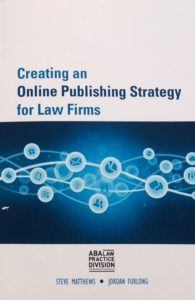
Lawyers don’t think of themselves as publishers. They think of themselves as counselors, advisors, litigators, defenders and problem solvers. Correct?
Well this book asks you to add publisher to the list. And by the time you’re finished reading all 85 pages (you made it through law school… you can do this in an hour, two tops!), you just may do that.
But before we delve deeper into the book, let’s explore the various schools of thought on how to market a law firm to give context (and maybe just a little gravity) to the online publishing option. Here’s a simplistic summary:
#1: Don’t do anything. Do a good job and you’ll get referrals. (Still works. But it needs a bit more help than it used to.)
#2: Network your face off, along the lines of ‘Never eat alone‘! (Also works… with the right personality that is. Extroverted, talkative, confident, gregarious, likeable and articulate. You can’t force this on the wrong profile.)
#3: Delegate or outsource. Assign it to someone else and walk away, hoping for the best. (Remember the infomercial for the rotisserie? Well, marketing a law firm isn’t like roasting a chicken! As tempting as it might be, you can’t just ‘set it and forget it’! )
#4: Get involved. Work with a marketing professional to guide the process. But bring your personalities into your materials, whatever you do to market your law firm. (Yes, this is where publishing comes in. Granted, it’s more work. But it’s also more effective, authentic and sustainable.)
As all my clients know, I’m a champion of the fourth school of thought: Get involved.
So are the authors of Creating an Online Publishing Strategy for Law Firms, Steve Matthews and Jordan Furlong. Their book provides a structured outline of how to go about implementing this approach.
The point is that if law firms can answer questions, create controversy and establish new viewpoints, they will be viewed as educators, leaders and experts by their intended audiences. So, essentially, law blogs, social media, white papers, newsletters and video, all publishing tools that have emerged in this digital age, are tremendous and powerful marketing opportunities to be leveraged with care.
In a generous mentor style, this book takes readers through the online publishing process, starting with strategy and ending with metrics (the right bookends in my humble opinion!). Here is a short excerpt from the section on tying your law blogs to your business development strategy:
…Suppose your strategy is to create a dominant market presence for your litigation practice. You could launch a blog to promote the experience and savvy of your trial lawyers , delivering insights into the trial process through first-person anecdotes by your litigators, reliving critical moments or important matters they have experienced and imparting lessons learned for clients along the way…
The idea is to closely tie the content you develop to your business development strategy and the types of clients that strategy envisions serving…
Whether you decide to do-it-yourself or work with a marketing professional, there is great value in learning more about this process.
It wouldn’t be going too far to ask everyone that will have a role in your marketing your law firm to read this book.
—
Related articles:
Professionals Wonder: To Blog or Not to Blog?










